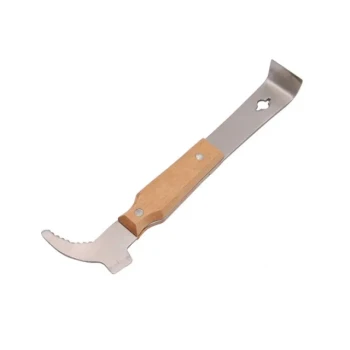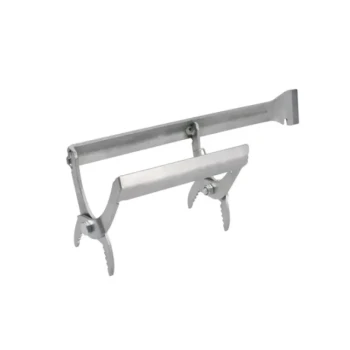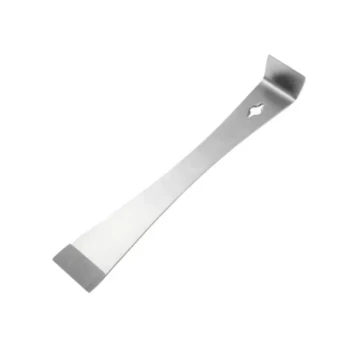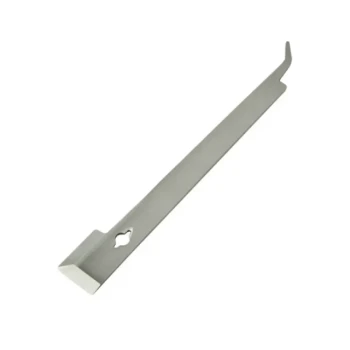At its core, a top bar hive is a single, horizontal bee hive that uses simple wooden bars laid across the top of a long trough. Unlike hives that use stacked boxes, bees in a top bar hive build their wax comb naturally, hanging it down from these removable bars. This design promotes a more natural and less physically demanding style of beekeeping.
A top bar hive is a management system built around a horizontal, single-story design. It prioritizes the bees' natural comb-building instincts and the beekeeper's ease of access over the standardized, high-yield approach of vertical hives.
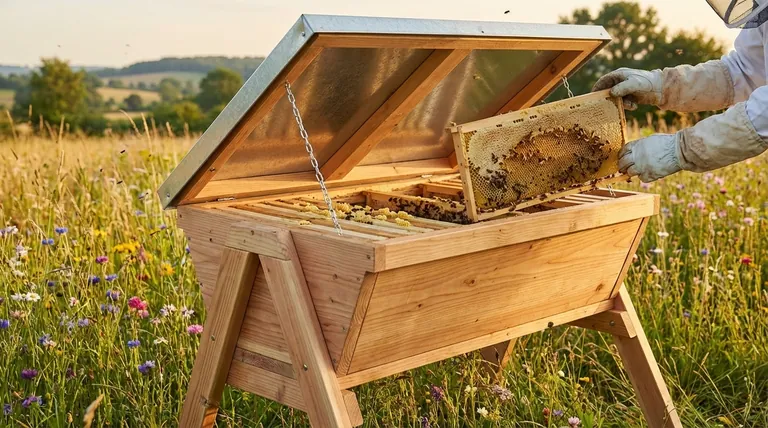
The Core Components of a Top Bar Hive
A top bar hive's simplicity is its greatest strength. While designs vary, they all share a few fundamental components that work together to create a functional home for a colony.
The Hive Body
The main structure is a long, trough-like box. The most common style, the Kenyan top bar hive, features sloped sides. This angle discourages bees from attaching their comb to the hive walls, making the bars easier to remove for inspection.
The Top Bars
These are the most critical element. A series of simple wooden bars, typically 1 3/8 inches wide, fit snugly across the top of the hive body. Bees use these bars as a starting point to draw out their own natural, foundationless wax comb.
Follower Boards
A follower board is a solid divider, shaped like the hive's internal profile. It acts as a movable wall, allowing the beekeeper to adjust the amount of space the colony occupies. This helps the bees manage temperature and humidity more efficiently, especially in a new or small colony.
The Roof and Legs
The hive is protected by a simple roof, which can be flat or gabled, to shield the colony from weather and predators. Most top bar hives are mounted on legs, which raise the entire structure to a comfortable working height for the beekeeper.
The Philosophy: A More Natural Approach
Choosing a top bar hive is often about embracing a different beekeeping philosophy—one that is less invasive and more in tune with the bees' natural behaviors.
Less Intrusive Inspections
In a vertical Langstroth hive, you must lift heavy boxes weighing 50-80 lbs to inspect the colony. With a top bar hive, you inspect one comb at a time by gently lifting a single top bar. The rest of the colony remains covered and undisturbed, which causes less stress to the bees.
Horizontal Management
The hive grows horizontally, not vertically. As the colony expands, the beekeeper simply moves the follower board down the length of the hive and adds more bars. There is no heavy lifting of supers or brood boxes required at any point in the season.
Foundationless Beekeeping
Top bar hives do not use pre-made wax or plastic foundations. The bees build their comb entirely on their own, determining the cell size themselves. This is a core tenet of what is often called "natural beekeeping."
Understanding the Trade-offs
While appealing, the top bar hive design comes with a distinct set of advantages and disadvantages that every potential beekeeper must consider.
Advantage: No Heavy Lifting
The single biggest benefit is ergonomics. Because the hive is at waist height and you only ever lift one comb at a time (weighing about 5-8 lbs), it is an excellent choice for people with back problems or limited physical strength.
Advantage: Simpler and Cheaper
The design is fundamentally simple. It requires fewer specialized components, no foundations, and no queen excluders. This often makes it less expensive to start and easier for a hobbyist to build themselves.
Disadvantage: Fragile Comb
The comb is only attached to the top bar, not supported by a frame on all four sides. This makes it extremely fragile. A beekeeper must handle the combs carefully, keeping them vertical to prevent the heavy, honey-filled comb from breaking off the bar.
Disadvantage: Lower Honey Yield
This system is not designed for large-scale honey production. Because the comb is often destroyed during harvest (crush and strain method) and is not standardized for extractors, the overall honey yield is typically lower than from a Langstroth hive.
Is a Top Bar Hive Right for You?
Choosing a hive type depends entirely on your personal goals as a beekeeper.
- If your primary focus is a natural, low-intervention approach with minimal physical strain: The top bar hive is an excellent choice that aligns perfectly with this philosophy.
- If your primary focus is maximizing honey production and using standardized equipment: The traditional Langstroth hive is a much better fit for your objectives.
- If your primary focus is backyard observation and a self-contained system: The all-in-one design and common addition of a viewing window make the top bar hive a compelling option for hobbyists.
Ultimately, the top bar hive offers a unique and rewarding way to work in partnership with your bees.
Summary Table:
| Feature | Top Bar Hive | Traditional Langstroth Hive |
|---|---|---|
| Design | Horizontal, single-story | Vertical, stacked boxes |
| Comb | Natural, foundationless | Standardized, on foundation |
| Management | Inspect one bar at a time | Lift heavy boxes (50-80 lbs) |
| Honey Yield | Lower, often crush & strain | Higher, compatible with extractors |
| Best For | Natural beekeeping, hobbyists, ergonomics | Commercial honey production, standardization |
Ready to embrace a more natural approach to beekeeping?
At HONESTBEE, we supply the durable, high-quality components that commercial apiaries and distributors need to build and maintain top bar hives. Our wholesale-focused operations ensure you get the reliable equipment your beekeeping business depends on.
Contact our experts today to discuss your beekeeping supply needs and discover the HONESTBEE advantage.
Visual Guide
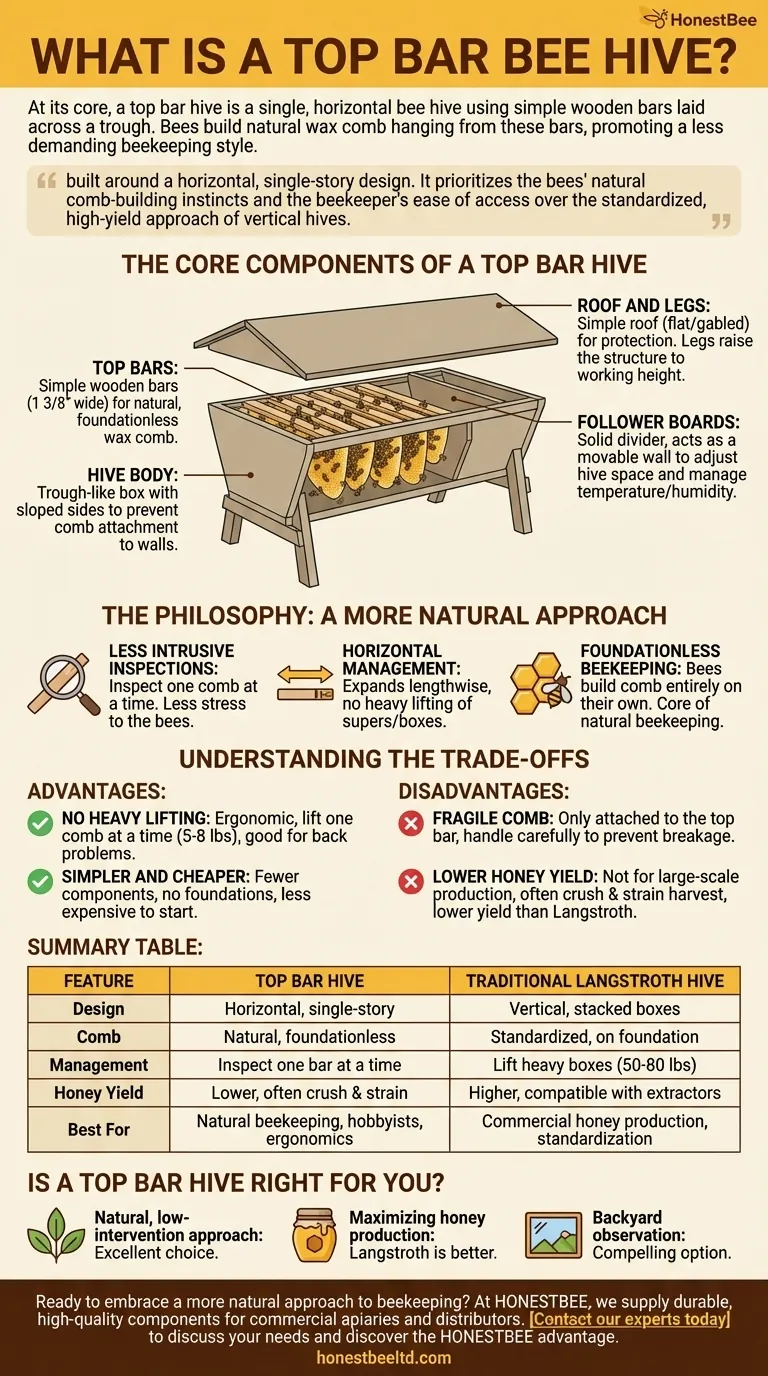
Related Products
- Long Langstroth Style Horizontal Top Bar Hive for Wholesale
- HONESTBEE Professional Multi-Functional Hive Tool with Ergonomic Wood Handle
- HONESTBEE Professional Long Handled Hive Tool with Precision Cutting Blade
- Top Bar Beehive for Beekeeping Wholesales Kenya Top Bar Hive
- HONESTBEE Advanced Ergonomic Stainless Steel Hive Tool for Beekeeping
People Also Ask
- What are the main differences between Langstroth hives and top bar hives? Choose the Right Hive for Your Beekeeping Goals
- What are the advantages of a top bar hive? Simpler, Bee-Centric Beekeeping for All
- What are the benefits of the top bar hive? A Guide to Ergonomic, Natural Beekeeping
- How are entrances designed in top bar hives? Master Beehive Layout for Maximum Honey
- How does the design of a top bar hive benefit beekeepers? Ergonomic & Natural Beekeeping for Hobbyists

